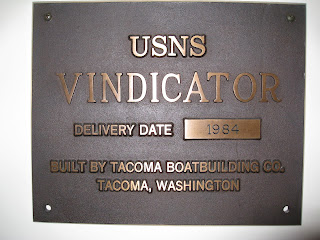July 3nd
The days before we set sail are spent loading the ship with
gear and equipment that will be needed for shark and Ulua fishing, handling and
tagging. Material and tools for mooring
construction and deployment are loaded and secured.
Our morning starts at 0600 at the Honolulu Fish Auction at
Pier 38 in Honolulu Harbor. Each morning at 0400 the vessels of the Hawaii
long-lining fleet offload the catch form their weeks out at sea. Yellowfin and
bigeye tuna are the majority of the fish that come in. Depending on the season,
location and depth you can also find lots of mahi mahi, opah, billfish, bottom
fish such as the Opakapaka and Uku, and deep sea such as the monchong. Long
rows of the fish are laid out in a large warehouse that is kept at a low
temperature. Very reminiscent of the fish market in Japan, the Honolulu Fish
Auction is the only commercial fish auction in the United States. We rummage
arm-deep through dumpster bins that are loaded with tuna heads and fish
carcasses that didn’t stay fresh on the boats. The tuna heads are the prized
bait pieces we go for, the workers at the auction sometimes hand us the cut off
heads from the large tuna they process. Going through a large tote full of
large dead fish and tuna heads is not for the faint of heart; the smell of dead
fish is made more pungent with the dripping blood and oily juices. You always
get some or a lot of fish blood/juice or flakes of flesh on you. With our
loaded bounty of tuna heads and whole mahi mahi we head to the University
Marine Center at Snug Harbor to load our fishing gear and mooring supplies. Our
lab keeps a shipping container full of fishing and shark tracking supplies in
the harbor. The University of Hawaii fleet is docked here as well.
The NOAA Ship Hi’ialakai (R 334) is home-ported at Ford
Island in Pearl Harbor along with her sister ships the Ka'imimoana and Oscar Elton
Sette. The ship was laid
down in 1984 as a US Navy Military Sealift Command Stalwart-Class ocean
surveillance ship USNS Vindicator (T-AGOS-3) by the Tacoma Boat Building
Company in Tacoma, Washington. She was then transferred to the US Coast Guard
in 1993 and then later transferred to the National Oceanic and Atmospheric
Administration (NOAA) and refitted as a research vessel in 2001 and was renamed
the Hi’ialakai which means “embracing
pathways to the sea”. The ship is outfitted for intensive scientific diving
operations with a diver locker and fill station, a 3-person recompression
chamber for immediate diver decompression treatment, and five small crafts that
can be launched amidships to transport teams of divers to working sites. To
learn more about the NOAAS Hi’ialakai andUSN
Vindicator visit: http://www.moc.noaa.gov/hi/
and http://www.navsource.org/archives/09/66/6603.htm.
There is a lot of
activity around the ship as scientists, crewmembers, NOAA officers and
longshoremen prep the ship and continue loading supplies and equipment for the
voyage while going over cruise plans and itinerary. Our departure week falls on
a particularly busy time for all of Pearl Harbor. The United States Navy hosts
and administers the largest multi-national joint warfare exercise Rim of
Pacific Exercise, (RIMPAC) on a biannual basis during June and July in
Honolulu, HI. An awesome display of dozens of ships can be seen docked in Pearl
Harbor and throughout the greater Honolulu area. An impressive view of the USS
Nimitz (CVN 68), the flagship of the carrier strike group, can be seen with her
squadrons of various aircraft from the bridge going to Ford Island. During the
exercise the USS Nimitz will be running on biofuel, making her the flagship of
the “Great Green Fleet” as an effort for a more environmentally friendly Navy.
More info about RIMPAC and the participating ships can be found at: http://www.cpf.navy.mil/rimpac/2012/about/
, and http://www.naval-technology.com/features/featurerimpac-2012-vessels-aircraft-countries/
.
After we loaded our mooring and
tagging supplies and stocking the ship’s walk-in freezer with totes full of
tuna heads, we headed to the NOAA building to receive a briefing on the
significance of the Northwestern Hawaiian Islands to Hawaiian culture. Information
on that subject are well publicized on the official website for the monument: http://www.papahanaumokuakea.gov/heritage/welcome.html

.jpg)






No comments:
Post a Comment